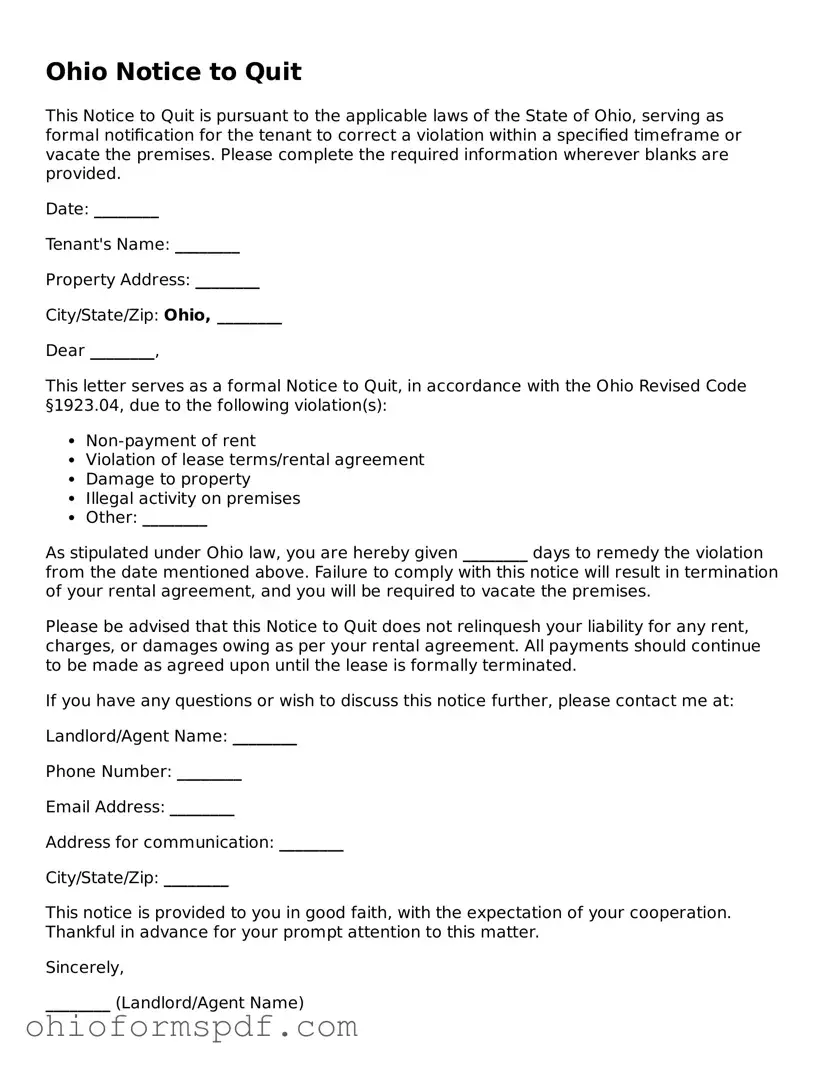What is an Ohio Notice to Quit?
An Ohio Notice to Quit is a legal document used by landlords to notify tenants that they must either correct a specific issue with their tenancy or vacate the premises by a certain date. This notice is often the first step in the eviction process and can be issued for reasons such as non-payment of rent, violation of lease terms, or holding over after a lease has expired.
When should an Ohio Notice to Quit be used?
This form should be used when a tenant in Ohio has either failed to pay rent, violated any terms of the lease agreement, or continued to occupy the property after the lease period has ended. The specific circumstances will determine the type of notice and the time frame given to the tenant to remedy the situation or leave the property.
How much time does a tenant have to respond to a Notice to Quit in Ohio?
The time frame for a tenant to respond to a Notice to Quit in Ohio varies depending on the reason for eviction. For non-payment of rent, the landlord must provide a 3-day notice. For lease violations, the notice period is usually 3 days as well, but this can vary depending on the specific terms outlined in the lease agreement. For holding over tenants, a notice period of 30 days is typical, assuming a month-to-month tenancy.
Can a tenant challenge an Ohio Notice to Quit?
Yes, a tenant can challenge an Ohio Notice to Quit. To do so, the tenant should first attempt to resolve the issue directly with the landlord. If a resolution cannot be reached, the tenant may need to attend a court hearing where they can present their case as to why they believe the notice is unjustified. Legal advice can provide guidance through this process.
What happens if the tenant does not comply with the Ohio Notice to Quit?
If the tenant does not comply with the Ohio Notice to Quit by either rectifying the issue within the given time frame or vacating the property, the landlord can proceed with filing an eviction lawsuit against the tenant. This legal action is taken in court, and a judge will decide whether the tenant must be forcibly removed from the property.
Does an Ohio Notice to Quit need to be notarized?
No, an Ohio Notice to Quit does not need to be notarized. However, it is essential to provide a copy of the notice to the tenant in a manner that can be tracked, such as certified mail, to ensure proof of delivery. Proof of receipt by the tenant is crucial if the eviction process advances to court.
Can an Ohio Notice to Quit be delivered electronically?
While Ohio law generally requires the Notice to Quit to be delivered in person or via certified mail, electronic delivery can be considered valid if the lease agreement specifically allows for notices to be delivered in such a manner. It is crucial to review the lease agreement to confirm the acceptable methods of delivering notices.
What information needs to be included in an Ohio Notice to Quit?
An Ohio Notice to Quit must include the name of the tenant(s), the address of the rental property, the reason for the notice (e.g., non-payment of rent, lease violation, etc.), the time frame in which the tenant must rectify the issue or vacate the property, and the date the notice was served. It is also helpful to include a reference to the specific lease term that has been violated if applicable.
Where can I find a template for an Ohio Notice to Quit?
Templates for an Ohio Notice to Quit can be found online through legal services websites, at local legal aid offices, or by consulting with a lawyer. It's important to ensure that any template used complies with Ohio law and is suitable for the specific situation.
